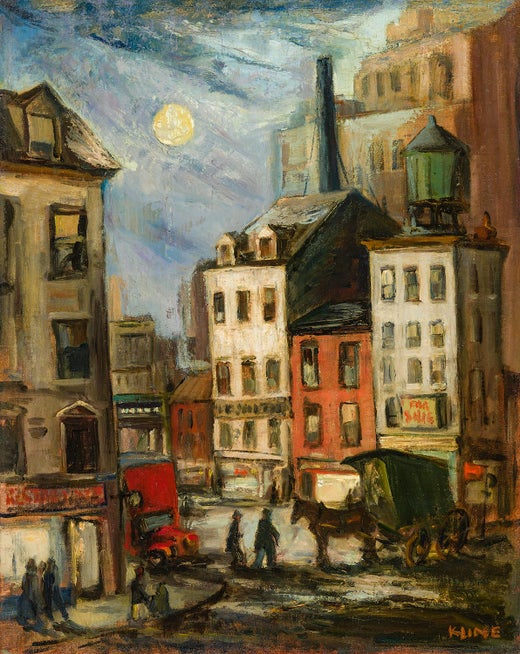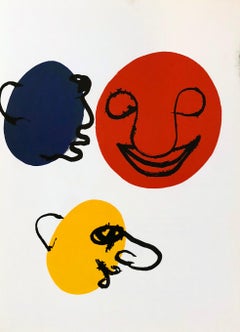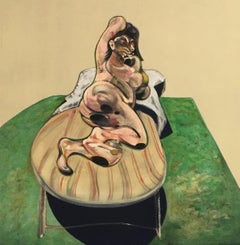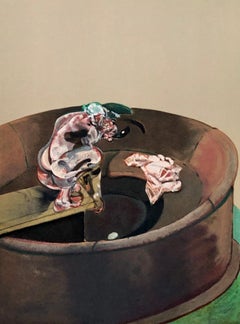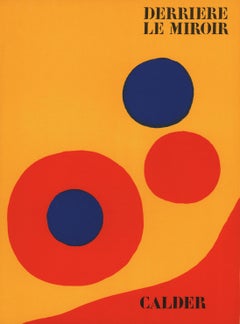Want more images or videos?
Request additional images or videos from the seller
1 of 9
Franz KlineFranz Kline at Sidney Janis (1950s exhibition poster)1958
1958
Price:$860
$925List Price
About the Item
- Creator:Franz Kline (1910 - 1962, American)
- Creation Year:1958
- Dimensions:Height: 22 in (55.88 cm)Width: 26 in (66.04 cm)
- Medium:
- Movement & Style:
- Period:
- Condition:Very good.
- Gallery Location:NEW YORK, NY
- Reference Number:1stDibs: LU35433309553
Franz Kline
Franz Kline (1910 – 1962) was an American painter. He is associated with the Abstract Expressionist movement of the 1940s and 1950s. Kline, along with other action painters like Jackson Pollock, Willem de Kooning, Robert Motherwell and Lee Krasner, as well as local poets, dancers, and musicians came to be known as the informal group, the New York School. Although he explored the same innovations to painting as the other artists in this group, Kline's work is distinct in itself and has been revered since the 1950s. Kline was born in Wilkes-Barre, a small coal-mining community in Eastern Pennsylvania. He studied art at Boston University from 1931 to 1935, then spent a year at the Heatherley School of Fine Art in London where he met his future wife, Elizabeth V. Parsons, a British ballet dancer. She returned to the United States with Kline in 1938, and Kline worked as a designer for a department store in New York state. He moved to New York City in 1939 and worked for a scenic designer. It was during this time in New York that he developed his artistic techniques and gained recognition as a significant artist. He later taught at a number of institutions including Black Mountain College in North Carolina and the Pratt Institute in Brooklyn. He spent summers from 1956 to 1962 painting in Provincetown, Massachusetts. Kline's artistic training focused on traditional illustrating and drafting. During the late 1930s and early 1940s he worked figuratively, painting landscapes and cityscapes in addition to commissioned portraits and murals. His individual style can be first seen in the mural series Hot Jazz, which he painted for a New York bar in 1940. The series revealed his interest in breaking down representative forms into quick, rudimentary brushstrokes. The personal style he developed during this time, using simplified forms, became increasingly more abstract. Many of the figures he depicted are based on the locomotives, stark landscapes, and large mechanical shapes of his native, coal-mining community in Pennsylvania. This is sometimes only apparent to viewers because the pieces are named after those places and objects, not because they actually look like the subject. With the influence of the contemporary New York art scene, Kline worked further into abstraction and eventually abandoned representationalism. From the late 1940s onward, Kline began generalizing his figurative subjects into lines and planes which fit together much like the works of Cubism of the time.
About the Seller
5.0
Vetted Professional Seller
Every seller passes strict standards for authenticity and reliability
Established in 2014
1stDibs seller since 2016
4,568 sales on 1stDibs
Authenticity Guarantee
In the unlikely event there’s an issue with an item’s authenticity, contact us within 1 year for a full refund. DetailsMoney-Back Guarantee
If your item is not as described, is damaged in transit, or does not arrive, contact us within 7 days for a full refund. Details24-Hour Cancellation
You have a 24-hour grace period in which to reconsider your purchase, with no questions asked.Vetted Professional Sellers
Our world-class sellers must adhere to strict standards for service and quality, maintaining the integrity of our listings.Price-Match Guarantee
If you find that a seller listed the same item for a lower price elsewhere, we’ll match it.Trusted Global Delivery
Our best-in-class carrier network provides specialized shipping options worldwide, including custom delivery.You May Also Like
The Ring
By Manfred Schwartz
Located in Astoria, NY
Manfred Schwartz (American, b. Poland, 1909-1970), The Ring, Abstract Figural Composition, Lithograph on Paper, mid 20th century, two nude figures in dangling hoop, numbered edition ...
Category
Mid-20th Century Modern Figurative Prints
Materials
Paper, Lithograph
"Somber Planet"
By Manfred Schwartz
Located in Astoria, NY
Manfred Schwartz (American, b. Poland, 1909-1970), "Somber Planet", Lithograph on Paper, mid 20th century, numbered edition "13/90" lower left, signed in pencil lower right, with the...
Category
Mid-20th Century Modern Abstract Prints
Materials
Paper, Lithograph
From Here to There
Located in Surfside, FL
Will Petersen, a painter, master printer and a poet, was born in
Chicago. (Amer. 1928-1994)
Will's formal art education began with classes at the Chicago Academy
of Fine Arts. As a ...
Category
1980s Modern Abstract Prints
Materials
Lithograph
Aiolio, from Imaginary Places III
By Frank Stella
Located in London, GB
Lithograph, screenprint, etching and aquatint printed in colours, with relief, 1998, signed in pencil, dated, numbered from the edition of 51 (there were also twelve artist's proofs)...
Category
1990s American Modern Abstract Prints
Materials
Etching, Aquatint, Lithograph, Screen
Orofena, from Imaginary Places III
By Frank Stella
Located in London, GB
Lithograph, screenprint, etching and aquatint printed in colours, with relief, 1998, signed in pencil, dated, numbered from the edition of 55 (there were also 14 artist's proofs), with the publisher's blindstamp, Tyler Graphics, Ltd., Mount Kisco, 54.6 x 55.2 cm. (21½ x 21¾ in.)
Catalogue Raisonne: Axsom 252
Over a period of four years, Stella created a body of prints whose titles all came from ‘The Dictionary of Imaginary Places’ by Alberto Mangual and Gianni Guadalupi. Each work from this series is recognisable for its teaming compositions of twisting, colliding and knotted forms. The shapes appear to spill out of their sheet, seemingly trying to escape their frames. As he had done since the ‘Swan Engravings...
Category
1990s American Modern Abstract Prints
Materials
Etching, Aquatint, Lithograph, Screen
Landscape at Stanton Street
By Willem de Kooning
Located in London, GB
Lithograph, 1971, on paper, signed and dated in pencil, numbered from the edition of 60,
published by Hollanders Workshop and Fourcade, New York, 75.7 x 56 cm. (30 x 2 2in.)
Category
1970s American Modern Abstract Prints
Materials
Lithograph
Plate X, from Album 19
By Joan Miró
Located in London, GB
Lithograph in colours, 1961, on BFK Rives wove paper, signed with the artist's monogram in black ink, numbered from the edition of 75 (the total edition included 15 impressions numbe...
Category
1960s Modern Abstract Prints
Materials
Lithograph
Plate XVI, from Album 19
By Joan Miró
Located in London, GB
Lithograph in colours, 1961, on BFK Rives wove paper, signed with the artist's monogram in pencil, numbered from the edition of 75 (the total edition included 15 impressions numbered...
Category
1960s Modern Abstract Prints
Materials
Lithograph
Plate VI, from Album 19
By Joan Miró
Located in London, GB
Lithograph in colours, 1961, on BFK Rives wove paper, signed with the artist's monogram in pencil, numbered from the edition of 75 (the total edition included 15 impressions numbered...
Category
1960s Modern Abstract Prints
Materials
Lithograph
"Flying Colors" framed, signed lithograph by Alexander Calder. Edition 11 of 100
By Alexander Calder
Located in Boca Raton, FL
Framed "Flying Colors" lithograph by Alexander Calder. Signed Calder in lower right corner. Edition 11 of 100.
Category
1970s Modern Abstract Prints
Materials
Lithograph
More From This Seller
View AllAlexander Calder lithograph Derrière le Miroir (Calder prints)
By Alexander Calder
Located in NEW YORK, NY
Alexander Calder Lithograph c. 1971 from Derrière le miroir:
Lithograph in colors; 15 x 11 inches.
Very good overall vintage condition.
Unsigned from an edition of unknown.
From: Derrière le miroir Published Paris c. 1971. Printed in France.
Derrière le miroir:
In October 1945 the French art dealer Aimé Maeght opens his art gallery at 13 Rue de Téhéran in Paris. His beginning coincides with the end of Second World War and the return of a number of exiled artists back to France.
The publication was created in October 1946 (n°1) and published without interruption until 1982 (n°253). Its original articles and illustrations (mainly original color lithographs by the gallery artists) who were famous at the time.
The lithographic publication covered only the artists exhibited by Maeght gallery either through personal or group exhibitions. Among them were, Pierre Alechinsky, Francis Bacon, Alexander Calder, Marc Chagall, Eduardo Chillida, Alberto Giacometti, Vassily Kandinsky, Ellsworth Kelly, Fernand Léger, Henri Matisse, Joan Miró, Saul Steinberg and Antoni Tapies.
Alexander Calder was an American artist best known for his invention of the kinetic sculptures known as mobiles. Calder also produced a variety of two-dimensional artworks including lithographs, paintings, and tapestries as seen in his Butterfly (1970). “My whole theory about art is the disparity that exists between form, masses, and movement,” the artist once said. Born on August 22, 1898 in Lawnton, PA, Calder turned to art in the 1920s, studying drawing and painting under George Luks and Boardman Robinson at the Art Students League in New York. Calder moved to Paris to continue his studies in 1926, where he was introduced to the European avant-garde through performances of his Cirque Calder (1926–1931). “I was very fond of the spatial relations,” he said of his interest in the circus. “The whole thing of the—the vast space—I’ve always loved it.” With these performances, along with his wire sculptures, Calder attracted the attention of such notable figures as Marcel Duchamp, Jean Arp, and Fernand Léger. Notably, it was his friend Duchamp that coined the term mobile—a pun in French meaning both “motion” and “motive”—during a visit to Calder’s Paris studio in 1931. His earliest mobiles moved by motors, but Calder soon abandoned these mechanics and designed pieces that moved by air currents or human interaction. Over the course of seven decades, along with his mobiles, he also produced paintings, monumental outdoor sculptures, works on paper, domestic objects, and jewelry. The artist lived in both Roxbury, CT, and Saché, France, before his death on November 11, 1976 in New York, NY. Today, his works are held in the collections of The Museum of Modern Art in New York, the National Gallery of Art in Washington, D.C., the Whitney Museum of American Art, New York, the Art Institute of Chicago, and the Tate Gallery in London.
Related Categories
Calder prints. Mid Century Modern. 1970s. Alexander Calder and Contemporary Art. Mid Century Modern. Calder clowns.
Category
1970s Modern Figurative Prints
Materials
Lithograph
$260 Sale Price
38% Off
1960s Francis Bacon lithograph (from Bacon derrière le miroir)
By (after) Francis Bacon
Located in NEW YORK, NY
1960s Francis Bacon lithograph from Derrière le miroir:
Well-suited for matting & framing, this original 1960's print is derived from Bacon's ...
Category
1960s Modern Figurative Prints
Materials
Lithograph
1960s Francis Bacon lithograph (from derrière le miroir)
By (after) Francis Bacon
Located in NEW YORK, NY
1960s Francis Bacon lithograph from Derrière le miroir:
Well-suited for matting & framing, this original 1960's print is derived from Bacon's ...
Category
1960s Modern Abstract Prints
Materials
Lithograph
$520 Sale Price
20% Off
Alexander Calder Lithographic cover Derrière le miroir 1973
By Alexander Calder
Located in NEW YORK, NY
Alexander Calder Lithographic cover: Derrière le miroir 1973:
Lithographic cover sheet; 15 x 11 inches.
Very good overall vintage condition.
Unsigned from an edition of unknown.
Por...
Category
1970s Modern Figurative Prints
Materials
Lithograph
$240 Sale Price
20% Off
1960s Antoni Tàpies lithograph (derrière le miroir)
By Antoni Tàpies
Located in NEW YORK, NY
Vintage 1960s Antoni Tàpies Lithograph
Portfolio: Derriere Le Miroir. Published by: Galerie Maeght/Aime Maeght, Paris 1967.
Lithograph in colors; 1967.
15 x 22 inches.
Center fold...
Category
1960s Modern Abstract Prints
Materials
Lithograph
$240 Sale Price
20% Off
Miró lithograph Derriere Le Miroir 1960s
By Joan Miró
Located in NEW YORK, NY
1960s Joan Miró Lithograph from Derrière le miroir:
Lithograph in colors; 15 x 11 inches.
Very good overall vintage condition.
Unsigned from an edition of unknown.
From: Derrière l...
Category
1960s Modern Abstract Prints
Materials
Lithograph
$240 Sale Price
20% Off
Recently Viewed
View AllMore Ways To Browse
Franz Kline Prints
Franz Kline Poster
Warhol Art Cash
Warhol Pasadena
Wassily Kandinsky 1911
Yaacov Agam Rainbow
Yaacov Agam Star
Yoshitomo Nara Skateboard
Zao Wou Ki Signed
A Calder Sky Bird
Adrian Brewer
Agnes Martin Praise
Albers Galerie Melki
Albert Turner
Alberto Hernandez
Alexander Calder Forest
Alexander Calder Signed Lithograph Balloons
Andy Warhol Green Stamps
